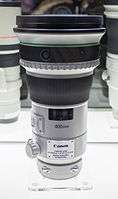Canon EF 400mm lens

The Canon EF 400mm are seven super-telephoto lenses made by Canon. These lenses have an EF mount that work with the EOS line of cameras. These lenses are widely used by sports and wildlife photographers.[1]
Canon currently manufactures three 400mm prime lenses:
- EF 400mm f/2.8L IS II USM[2]
- EF 400mm f/4 DO IS II USM
- EF 400mm f/5.6L USM
The EF 400mm f/5.6L USM is Canon's least expensive 400mm lens and one of the best deals for a super telephoto 400mm focal length lens in the industry. Exceptional sharpness, minimal vignetting, very low distortion, and superb handling of chromatic aberration means this lens does not require image corrections in digital post production software. Having a maximum aperture of f/5.6, it is relatively slow.
The 400mm f/4 DO IS II USM, which replaced an earlier version of the same lens in 2014,[3] is one of only two Canon lenses that make use of diffractive optics (the other is the Canon EF 70-300mm lens). The use of diffractive optics allows the lens to be significantly lighter than it might otherwise be.[4][5]
These lenses are compatible with the Canon Extender EF teleconverters.
Specifications of the EF 400mm lenses
| Attribute | f/2.8L USM | f/2.8L II USM | f/2.8L IS USM | f/2.8L IS II USM | f/4 DO IS USM | f/4 DO IS II USM | f/5.6L USM |
|---|---|---|---|---|---|---|---|
| Image |  |
 |
 |
 | |||
| Key features | |||||||
| Full-frame compatible | |||||||
| Image stabilizer | |||||||
| Ultrasonic Motor | |||||||
| L-series | |||||||
| Diffractive Optics | |||||||
| Macro | |||||||
| Technical data | |||||||
| Aperture (max-min) | f/2.8-f/32 | f/4-f/32 | f/5.6-f/32 | ||||
| Construction | 9 groups / 11 elements | 13 groups / 17 elements | 12 groups / 18 elements | 6 groups / 7 elements | |||
| # of diaphragm blades | 8 | 9 | 8 | 9 | 8 | ||
| Closest focusing distance | 4 meters | 3 m | 2.7 m | 3.5 m | 3.3 m / 10.83 ft | 3.5 m | |
| Max. magnification | 0.11x | 0.15x | 0.17x | 0.12x | 0.13x | 0.11x | |
| Horizontal viewing angle | 5°10' | ||||||
| Vertical viewing angle | 3°30' | ||||||
| Diagonal viewing angle | 6°10' | ||||||
| Physical data | |||||||
| Weight | 13.44 lb / 6.1 kg | 13.03 lb / 5.91 kg | 11.83 lb / 5.37 kg | 8.48 lb / 3.85 kg | 4.27 lb / 1.94 kg | 4.63 lb / 2.10 kg | 2.8 lb / 1.25 kg |
| Maximum diameter | 6.57" / 167mm | 6.41" / 163mm | 5.03" / 128mm | 5.04" / 128mm | 3.54" / 90mm | ||
| Length | 13.70" / 348mm | 13.74" / 349mm | 13.50" / 343mm | 9.16" / 232.7mm | 9.18" / 232.7mm | 10.09" / 256.5mm | |
| Filter diameter | 48mm | 52mm drop-in filter | 77mm | ||||
| Accessories | |||||||
| Lens hood | ET-161B II | ET-155 | ET-155 (WII) | ET-120 | ET-120 (WII) | Built-in | |
| Case | 400 | 400C | 400B | 400D | LH-D29 | ||
| Retail information | |||||||
| Release date | April 1991 | March 1996 | September 1999 | August 2011 | December 2001 | September 2014 | May 1993 |
| Currently in production? | |||||||
| MSRP $ | 870,000 yen | 980,000 yen | $7,999 | $9,999 | $6,469 | $6,899 | $1,249 |
Use in astronomy
Canon 400 mm f/2.8 L IS II USM lenses are used in the Dragonfly Telephoto Array.[6] The array is designed to image objects with low surface brightness such as some satellite galaxies.[7][6] The telescope Array started with three lenses but this has since increased to 24 with plans for 50.[6][7]
References
- ↑ the-digital-picture.com
- ↑ usa.canon.com
- ↑ "Canon U.S.A. Celebrates 75 Years Of Optics Heritage With The Addition Of Three New Lenses" (Press release). Canon U.S.A. September 15, 2014. Retrieved September 15, 2014.
- ↑ the-digital-picture.com
- ↑ the-digital-picture.com
- 1 2 3 Abraham, Roberto G; van Dokkum, Pieter G (2014). "Ultra–Low Surface Brightness Imaging with the Dragonfly Telephoto Array". Publications of the Astronomical Society of the Pacific. 126 (55). arXiv:1401.5473. Bibcode:2014PASP..126...55A. doi:10.1086/674875. Retrieved 4 May 2017.
- 1 2 Barss, Patchen (28 January 2016). "How to Discover a Galaxy with a Telephoto Lens". Nautilus. NautilusThink Inc. Retrieved 4 May 2017.
External links
| Wikimedia Commons has media related to |